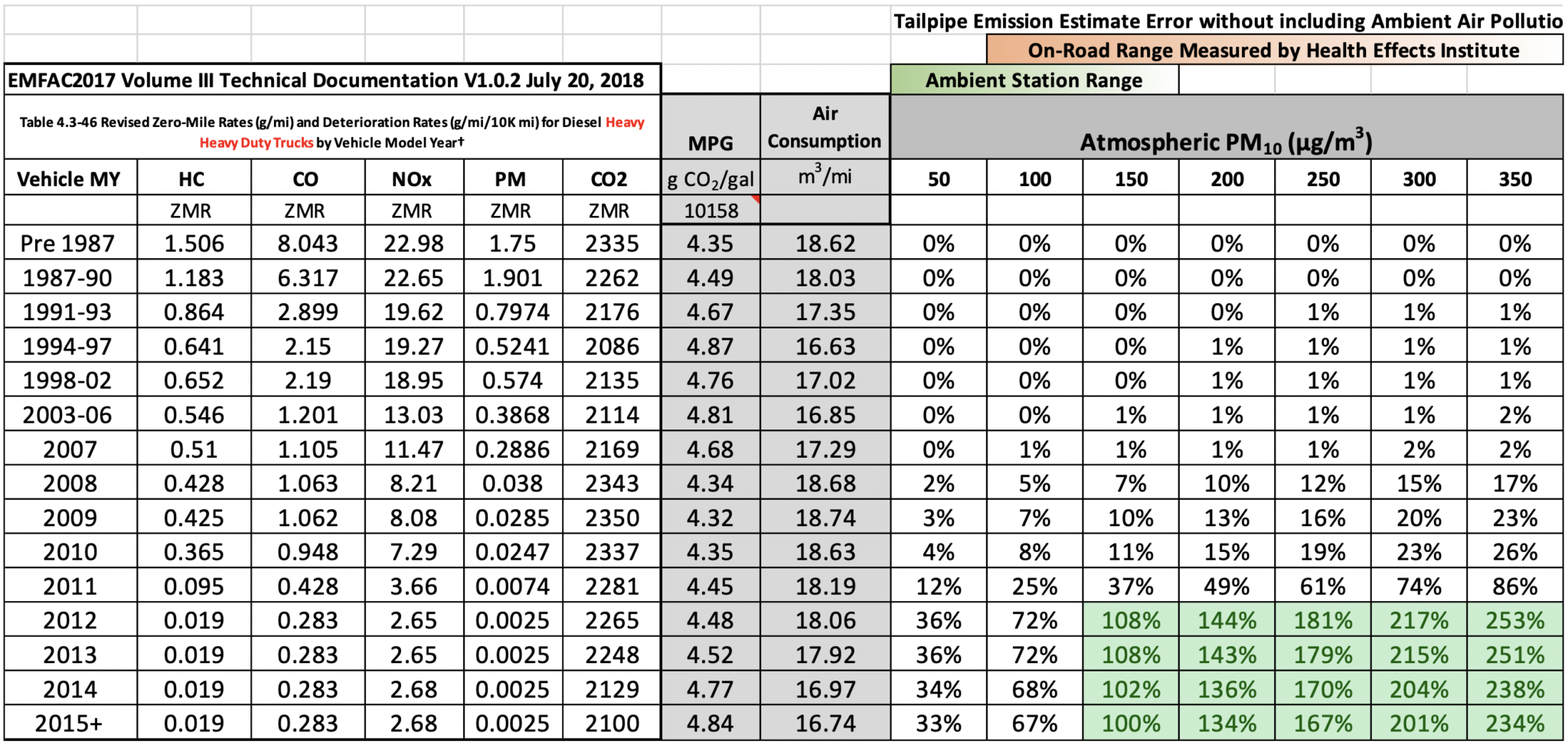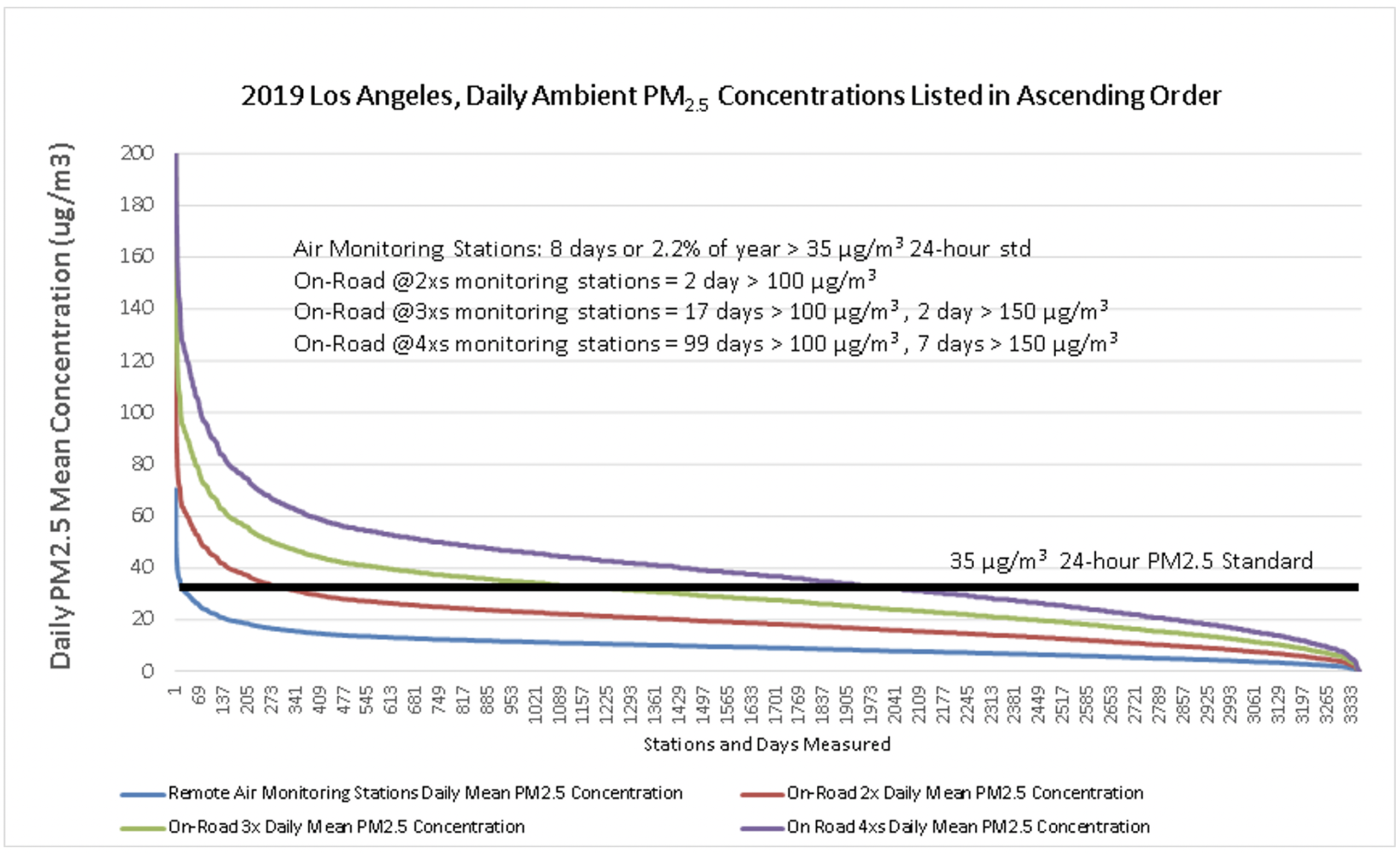Is it time for CARB & EPA to revise vehicle emission and emission-reduction estimates?
Link to article: https://stillwaterassociates.com/is-it-time-for-carb-epa-to-revise-vehicle-emission-and-emission-reduction-estimates/
February 2, 2021
By Gary Yowell
The California Air Resource Board (CARB) and the U.S. Environmental Protection Agency (EPA) are empowered through the Clean Air Act and other legislation to expeditiously reduce the severity and number of violations to air quality standards.[1] Current environmental policy uses annual pollution levels to measure and define success, but the legislative authority to enact such policies is much narrower. The Clean Air Act grants CARB and EPA authority to clean the air when air quality days exceed air quality standards (air violation days). The Clean Air Act does not grant CARB or EPA authority to enact policies concerning non-air-violation days. As such, environmental policy concerning particulate matter (PM) emissions from vehicles, for example, should target the handful of air violation days each year which are in violation of PM standards and not apply to the remaining “clean air” days that make up most of the year. Current regulatory policy, however, focuses on annual emissions accounting and outdated emission testing protocols rather than ensuring fewer days result in non-compliance with air quality standards.
In this article, we discuss how CARB and EPA could update their protocols to return to the mandate granted by the Clean Air Act while more accurately accounting for real-world vehicle emissions and the benefits of modern internal combustion engine (ICE) technologies. Due to CARB’s and EPA’s successful implementation of vehicle regulations, for example, PM emissions from diesel ICE vehicles have declined by 99.9% since the mid-1980s. These new “Super Clean Diesels” help reduce the number of PM violation days, but this advancement is not accounted for in current regulatory policy. Let’s explore how CARB and EPA could correct this oversight in current and forthcoming environmental policies.
CARB’s zero-emission vehicle (ZEV) program (which is part of California’s Advanced Clean Cars Program) and Governor Newsom’s Executive Order banning the sale of new gasoline and diesel vehicles beginning in 2035 are based on the aforementioned errant environmental policy analysis. CARB’s latest Clean Truck Rules, among other heavy-duty (HD) ZEV programs, claims HD ZEVs reduce PM emissions relative to current and future diesel vehicles. This incomplete (and therefore inaccurate) policy analysis originated in the 1970s when EPA and CARB first omitted ambient air pollution consumption effects in their vehicle emission inventory assessments. Instead, they equate the emission assessments of vehicles tested in a pollutant-free laboratory environment to real-world operation. Back in the 1970s, 80s, and 90s, diesel engines’ tailpipe emissions were so high that including ambient air pollution in vehicle emissions analyses did not materially change emission results. Since the 2007 model-year, however, diesel engines have had 99.9% reduced PM emissions from pre-1987 levels. These engines’ tailpipe emissions are so low that when operated in high air pollution areas, the engines reduce the on-road air pollution with their emission control system. Consequently, omitting air pollution consumption and clean-up by these Super Clean Diesels significantly overestimates their PM emissions in the real world. The data analysis of this article excludes additional reductions beyond PM, although further analysis would likely verify similar results on other regulated pollutants.
Table 1, below, lists CARB’s Emission Factors listed in EMFAC2017. These data show estimated vehicle emissions for new Heavy-Duty Diesels (HDDs) at the zero miles rates (ZMR) – that is to say, emissions as a brand-new heavy-duty vehicle before the vehicle ages and sees an increase in emissions. For PM analysis, this is a good starting point because PM emissions, unlike emissions of other criteria pollutants, change little as the vehicle ages.
Table 1. CARB EMFAC HDD Estimated Emissions with and without Ambient PM Pollution 
Source: EMFAC2017 Volume III Technical Documentation V1.0.2 July 20, 2018
The left side of Table 1 shows the abridged CARB EMFAC estimated emission factors – which are laboratory results, excluding ambient air pollution. In the middle (gray) section of Table 1, we added in the corresponding fuel economy and engine’s air consumption based on EMFAC CO2 values. The seven columns on the right show the percent of tailpipe emission PM concentrations as a percent of the ambient air PM indicated at the top of each column.
For the older vehicle emissions (up until 2006), the analytical error created by omitting ambient PM consumption is essentially zero. This justified the exclusion of ambient PM from these older vehicles at the time when the policy analysis was initially performed. By 2009, however, the error created due to omitting HDD ambient PM consumption becomes significant.
CARB’s EMFAC table reveals the weighted-average vehicle sold in a model-year (MY). Unlike cars and light-duty trucks, brand-new HDD vehicles’ engines may be the same MY as the vehicle MY, or up to two years older. In 2007, all diesel engines manufactured nationwide were required to use diesel soot filters reducing PM (and toxic) emissions by 98-99%, resulting in 0.0025 g PM/mile emission rates. For the purposes of this article, we call these newer HDD vehicles with soot filters “Super Clean Diesels.” CARB’s EMFAC table for the 2007 MY estimates 24% of the vehicles sold had these 2007 MY Super Clean Diesel engines, 72% had the 2006 MY engines, and a small fraction still had 2005 MY engines for a weighted-average emission rate of (0.2886 g PM/mile). The 24% of HDD sold in 2007 with Super Clean HDD vehicles were emitting 0.0025 g PM/mi. These Super Clean Diesel vehicles, when operated in ambient conditions at 100 ug/m3, had emissions 73% lower than CARB’s estimated value. As shown in the green shaded area of the table above, when these HDD vehicles were operated in environments with 150 ug/m3, these Super Clean Diesels proved to have zero or negative PM emissions (they were reducing more ambient PM than the engine emitted), and their emissions were 108% below CARB’s estimate for the HDD class as a whole.
Figure 1 below shows how a Super Clean Diesel vehicle reduces air pollution. The same emissions-control equipment that provides 99.9% PM reduction from the combustion of the fuel also has the added benefit of reducing the PM from the ambient air taken in by the engine. When the ambient air is of poor quality, today’s Super Clean Diesel engines clean up the air before emitting it out of the tailpipe. The below example shows how the Super Clean Diesel reduces ambient PM pollution 0.0011g/mile when driven in a 200 µg/m3 environment. By contrast, a ZEV (which does not intake ambient air or emit exhaust from a tailpipe) driven through this same ambient air pollution would leave 0.003612 g/mi PM, this is the PM mass that the diesel consumes.
Figure 1. Air Pollution Moving through a Super Clean Diesel Vehicle

Instead of the current policy assumption that all diesels operate in a zero-pollution environment, what is the appropriate ambient air pollution metric for estimating on-road diesel vehicles emissions?
Regulatory authorities are only empowered to reduce the severity and number of violations to air quality standards and achieve expeditious attainment of such standards.[2] To inform such regulatory action, ambient monitoring stations measure PM remotely, away from major highways. According to a Health Effects Institute study, roadway PM2.5 were found to be two- and six-times higher than the remotely located stations.[3] According to CARB’s 2016 emission inventory, around 5% of PM10 pollution comes from vehicle exhaust. Road and ambient dust, sea salt, re-entrained sea salt, wildfire smoke, road wear, tire, and break wear are also PM2.5 sources. In fact, 40-50% of roadway PM are not generated by mobile sources according to Health Effects Institute findings.
Using roadway PM levels, however, we can estimate on-road HDD emissions from CARB’s EMFAC laboratory tests and estimate Super Clean Diesels’ ability to reduce PM to meet federal and state ambient air quality standards.[4] Figure 2, below, shows that in 2019 the Los Angeles air basin experienced eight days above the 24-hour PM2.5 standard. Table 2 below displays the number of high on-road PM days in 2019.
Table 2. High On-Road PM Days (2019)

By this crude example, there are more than enough on-road high PM days for Super Clean Diesels to be negligible, zero, and even negative PM emitters during the eight violation days. Super Clean Diesels should meet the Clean Air Act objective – to “reduce the severity and number of violations to air quality standards.” More analysis is needed, but today’s Super Clean HDDs clearly have the potential to meet CARB’s goal of “providing necessary emission reductions from vehicular sources for all of California’s nonattainment areas to meet federal ambient air quality standards.”
Figure 2. Los Angeles 2019 Daily Ambient PM2.5 Concentrations Listed in Ascending Order

Source: https://www.epa.gov/outdoor-air-quality-data/download-daily-data
Annual Emissions Accounting needs to Re-examined
CARB and EPA policies, emission inventories, and State Implementation Plans are all based on annual emissions – this practice should be reexamined. As the above analysis shows, PM2.5 24-hour violations, occurred eight days, or 2.2% of the year, meaning 97.8% of the time the basin was in attainment, and 97.8% of the annual data did not inform how to, per the Clean Air Act, reduce severity and number of violations to the ambient air quality standards. To fulfill the obligation of the Clean Air Act and other environmental regulatory enabling legislation environmental policy and efforts must focus on remedies addressing the eight days or 2.2% of the days of the year in which the ambient air quality is in violation of the standard.
The fact that Super Clean Diesel vehicles have tailpipe PM emissions below that of the ambient air means that they are uniquely effective at reducing air pollution on those exceedance days – exactly when these emission reductions are needed to protect sensitive populations with acute health issues. Further, since this is a localized benefit, it disproportionately benefits environmental justice communities (people living adjacent to the freeways.)
Conclusion
CARB and EPA are empowered through the Clean Air Act to reduce the severity and number of violations to air quality standards and achieving expeditious attainment of such standards. CARB’s significant regulatory progress in reducing ambient PM pollution violations has led to the current annual accounting practice misguiding 97.8% of the time instead of guiding violation reduction policies. Annual emission accounting no longer aligns with the legislative authority to address the air violation days to bring to healthy air quality.
An air-violation-focused emission accounting, coupled with including ambient air pollution consumption and clean-up, would have prevented the false conclusion that ZEVs provide greater PM reductions than Super Clean Diesel vehicles. EPA and CARB policies should account for all internal combustion engines’ ambient on-road air pollution consumed and emissions during ambient air quality exceedances. It is also time for EPA and CARB to re-estimate, at a minimum, the PM environmental benefit from ZEVs considering this analysis. Further study may find results align across other regulated pollutants.
[1] The 1990 Clean Air Act was amended to provide for attainment and maintenance of health-protective national ambient air quality standards, for ozone, carbon monoxide and particulate matter (PM10) non-attainment areas.
[2] The 1990 Clean Air Act was amended to provide for attainment and maintenance of health-protective national ambient air quality standards, for ozone, carbon monoxide and particulate matter (PM10) non-attainment areas.
[3] Concentrations of Air Toxics in Motor Vehicle–Dominated Environments Eric M. Fujita, David E. Campbell, Barbara Zielinska, William P. Arnott, and Judith C. Chow
[4] ACT CARB’s Stated goal is to “providing necessary emission reductions from vehicular sources for all of California’s nonattainment areas to meet federal ambient air quality standards (Health & Safety Code Sections 39002, 39003, 39602.5, 43000, 43000.5, 43013, 43018).”
